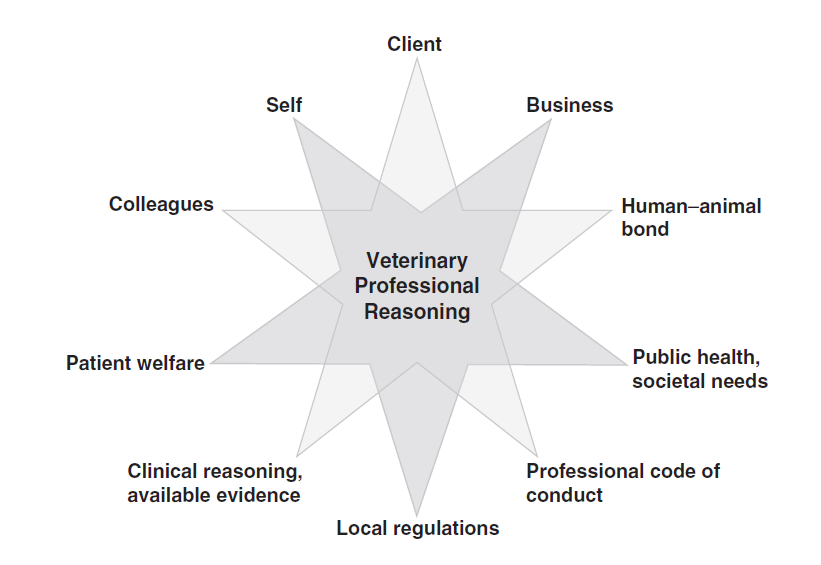Apply
3. Individualised application of the evidence into practice
3.1. Consider the individual circumstances of your clinical scenario
3.1 Consider the individual circumstances of your clinical scenario
Now that you have decided whether your evidence is relevant to your clinical question, you need to decide whether the evidence is applicable to your individual set of circumstances.
Let’s revisit the definition of evidence-based veterinary medicine:
Evidence-based veterinary medicine is the use of the best relevant evidence in conjunction with clinical expertise to make the best possible decision about a veterinary patient. The circumstances of each patient, and the circumstances and values of the owner/carer, must also be considered when making an evidence-based decision. (Centre for Evidence-based Veterinary Medicine)
Now you need to use your professional knowledge, skills and judgement to consider whether the evidence is applicable to the individual set of circumstances surrounding your clinical dilemma. Listed below are some of those circumstances to be considered:
- the patient–(owner)–clinician relationship
- a sensitivity to the human-animal bond
- expectations of end-of-life care
- animal welfare
- veterinary business practice
- funding and insurance models
- equipment limitations
- varying cultural beliefs
- clinician confidence in new procedure or treatment protocol…
It is useful to apply a framework within which to consider these factors. Armitage-Chan (2020) has developed such a framework which takes the clinician through a step-by-step process of ‘professional reasoning’ (Figure 1) and this could be used as a guide when integrating evidence into practice. Through a process of information gathering, the clinician must consider all the stakeholders involved in the decision-making process, represented by the star diagram below.
Figure 1: Stakeholders in veterinary professional reasoning
(from Armitage-Chan, 2020; included with permission from the author, the Journal of Veterinary Medical Education and the University of Toronto Press)

The diagram can be helpful to consider how various dilemmas may arise; sometimes your clinical decision may not fit with the best evidence, it may not always be the same as that of your colleagues.
Recent work on identity formation suggests that when veterinarians act in a way which doesn’t sit well with their personal goals and values, they can experience identity dissonance, which can lead to anxiety and a lack of psychological well-being (Armitage-Chan and May, 2019).
It is useful to recognise that there may be multiple, equally valid ways of approaching a clinical scenario. The following examples help to illustrate potential dilemmas that may arise in everyday situations.
Example Scenario
Elderly pet dog – what are the options for the client?
An elderly couple with no pet insurance, present their bitch, Molly, who is unwell. You diagnose an open pyometra. You have read a recent Knowledge Summary with the following clinical bottom line:
Ovariohysterectomy combined with antibiosis is more effective in achieving clinical cure than systemic antibiosis alone. Systemic antibiosis may be associated with recrudescence of the pyometra and the evidence base is weaker for this approach. Read the full Knowledge Summary
You know that surgery would give a better chance of a good short- and long-term outcome for Molly. Your other options are medical management with antibiotics (with a high risk of recurrence, even if successful in the short-term), or euthanasia. Molly is still eating and cardiovascularly stable and the owners have financial limitations to undertaking an ovariohysterectomy.
In this case, together with the owners you decide that you will trial a course of antibiotics with a view to re-assessing Molly regularly and if her condition worsens, she will be euthanised. You might feel uncomfortable with this approach, knowing that surgery could successfully treat the pyometra; you make sure you discuss further options, such as euthanasia, if there is no improvement and warn the owners of the likelihood of recurrence.
Example Scenario
The cost of efficiency
Your interest in infection control led you to read an article in a veterinary nursing publication about using alcohol hand rubs as an alternative to the more traditional hand scrubbing. An online search of the current literature leads you to a knowledge summary with the following clinical bottom line:
The current literature suggests that the use of alcohol hand rubs provide similar, if not better, reductions in bacteria colony forming units [when compared to traditional methods of hand scrubbing], both immediately after hand antisepsis and in the immediate postoperative period. Read the full Knowledge Summary
Using alcohol hand rubs would mean that the time spent ‘scrubbing in’ will be reduced, with the added potential benefit of better compliance and a reduction in patient anaesthetic time, especially when time is more critical.
At the moment the practice buys scrubbing brushes and chlorhexidine which are a similar cost to alcohol hand rub and is considering changing. However, a global pandemic made all alcohol hand rubs very difficult to source resulting in the cost of these products rising, and outweighs what the practice is already paying for scrub brushes and chlorhexidine. Therefore, the practice decides the current protocol (scrubbing with chlorhexidine) will remain in place and the lead nurse is tasked with reviewing the situation (cost and availability of alcohol hand rub) at regular intervals.